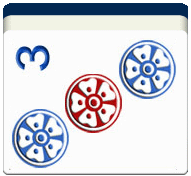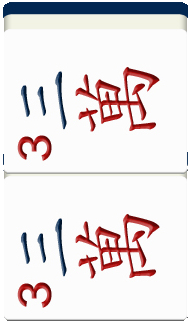
First Published Thursday, May 31, 2007
The Score
Now for the hard part: Scoring
Scoring is just about the most difficult part of any mahjong rules. In the Official Chinese Rules, there is a point system and a minimum amount of points. In the American version, there are certain hands decided already and point value assigned to each hand.
Reach mahjong still uses the Base-Points x Hand-Points method. It is a little bit more complicated, but consider this: In Reach Mahjong, there are 36 types of Hands. In the Chinese Official Rules there are 85. Now which one sounds more complicated?
Plus, there is a handy chart right here. That will help you keep track of your points. At first just print this off (click here for printable page) and use it when you are playing. Later you’ll have it memorized (there are thousands of people in Japan and other places in the world who have memorized this scoring system, don’t let them beat you, join them!!!).
Base Points
Let’s talk about Base-Points, baby…Let’s talk just you and me
Let’s talk about all the pungs, quads, pairs and waits, that could be
Let’s talk about it,Let’s talk about BASE
Yeah! Did you enjoy my little singing bit? Just be glad that you only had to read it on the screen and not hear me making it up just now 😉
Every time you go out on a hand you automatically get 20 Base-Points. GO YOU!!
So what?
Exactly. Considering the smallest bone is worth 100 points, 20 points sounds pretty worthless. So how can you get more base points? One word: SETS. Groups of 3 and 4 (Trips, pungs/Pons and Quads if you forgot) are all worth Base-Points. Sometimes you can even get points for pairs. It’s really quite simple and there is a really beautiful graph made by yours truly at the end to sum up all of the points. I officially give you permission to print it, frame it and hang it in your bedroom. I’ll even sign it if you want (^.^)
Pairs
Pairs of value are worth points for you. If you have a pair of any Value Tiles, it’s worth 2 points. If you have a Double-Valued tile, it’s worth 4 points by JPML rules! (Most other organizations only award 2 points, even for double-value tiles).
Examples of Value Pairs:
![]()
![]()
![]()
![]()
![]()
![]()
If you have 2, the 3 Colored Dragons are ALWAYS Value Pairs
![]()
![]()
![]()
![]()
![]()
![]()
![]()
![]()
If a Wind Tile is your Seat Tile OR the Round Wind, it counts as a Value Pair
Examples of Double Value Pairs:
![]()
![]()
![]()
![]()
If your Seat Wind and the Round Wind are the same, it’s a DOUBLE VALUE Pair
Triples
A group of 3 of any Honor Tiles is worth 4 points if you complete the set from someone else by punging and 8 points if you make it all by yourself. 1’s and 9’s as well! In short, all TERMINALS/HONORS are worth points if you have a group of 3.
Examples of punged Terminals/Honors:
![]()

![]()
![]()
![]()

![]()

![]()
(1 and 9 in each suit Count as Terminals)
![]()
![]()

![]()
![]()


![]()
![]()
All Honor Tiles Count as regardless of Value
Examples of Concealed Terminals:
![]()
![]()
![]()
![]()
![]()
![]()
![]()
![]()
![]()
1 and 9 in each suit Count as Terminals
![]()
![]()
![]()
![]()
![]()
![]()
![]()
![]()
![]()
All Honor Tiles Count regardless of Value
More Trips
The numbers 2-8 are worth half as much. Can you do the math? I believe YOU can do it, so why don’t you just check my answer for me: A group of 3 consisting of numbers 2-8 are worth 2 points if you complete the group from someone else and 4 if you make the group all by yourself.
Examples of punged Simples
![]()

![]()
![]()

![]()
![]()

![]()
punged Trips of tiles 2-8
Examples of Concealed Simples
![]()
![]()
![]()
![]()
![]()
![]()
![]()
![]()
![]()
Concealed Trips of tiles 2-8
Quads
A group of 4 is worth four times as much as a Group of 3. That means: Concealed groups of 4 consisting of TERMINALS are worth 32. If you use someone else’s help, you will only get 16 points for those.
Examples of punged Terminal Quads and Add-a-Quads:

![]()
![]()
![]()
![]()
![]()
![]()

![]()

![]()
1 and 9 in each suit Count as Terminals
![]()

![]()
![]()
![]()

![]()
![]()
![]()
![]()

All Honor Tiles Count as Terminals, regardless of Value
Examples of Concealed Terminal Quads:
![]()
![]()
![]()
![]()
![]()
![]()
![]()
![]()
![]()
![]()
![]()
![]()
1 and 9 in each suit Count as Terminals
![]()
![]()
![]()
![]()
![]()
![]()
![]()
![]()
![]()
![]()
![]()
![]()
All Honor Tiles Count as Terminals, regardless of Value
What if your groups are made up of tiles 2-8? That’s right, 8 points for melded groups and 16 points for concealed groups. Examples of punged
Simple Quads punged Quads and Add-a-Quads of tiles 2-8
![]()
![]()
![]()

![]()

![]()
![]()
![]()

![]()
Examples of Concealed Simple Quads
![]()
![]()
![]()
![]()
![]()
![]()
![]()
![]()
![]()
![]()
![]()
![]()
Concealed Quads of tiles 2-8
OK, so those are 3 ways to get Base-Points. Are there anymore?? You run a hard bargain, ok, how about if I throw in some points for difficult waits? WaitsIf your hand is complete except for that 1 pesky tile (e.g. you are READY), the tile that you are waiting for may be worth points.Actually, it is ONLY worth points (2, to be precise), if you are waiting for EXACTLY one type of tile. For Example:
One-Sided Wait:
Examples
Waiting for 3 of Dots ![]()
![]()
Waiting for 7 of Bams ![]()
![]()
Waiting for 3 of Craks ![]()
![]()
Middle wait:
Waiting for 4 of Dots ![]()
![]()
Waiting for 5 of Craks ![]()
![]()
Waiting for 6 of Bams ![]()
![]()
Lonely Wait:
Waiting for one more East ![]()
Waiting for one more 5 of Craks ![]()
That about does it. What? You want more?? Ok, but this is the LAST WAY to get Base-Points. And I will need to whisper it to you: You can also get Base-Points depending on how you go out.
Type of Win
If you win on a Self-Draw (meaning you pick the tile yourself), then you get 2 more base points.If your hand is entirely concealed and you get a River-Win (meaning someone else throws away your winning tile), then you get 10 more base points!! Really?! This sounds too good to be true!! What is the catch? The catch is that there are 3 exceptions to the Type of Win BP
- Self-Drawn Peace-Hand: If your hand is a Peace Hand and you draw the winning tile yourself, it should be worth 22 Base-points (20 just for going out and 2 for Self-Drawn win). However, You will only get 20 Base-points for it. Actually, the Self-Drawn Peace-Hand is the only hand that will ever be worth the minimum 20 points. What about your hard-earned 2 points you say? Come on, 2 points is a small price to pay for Peace.

